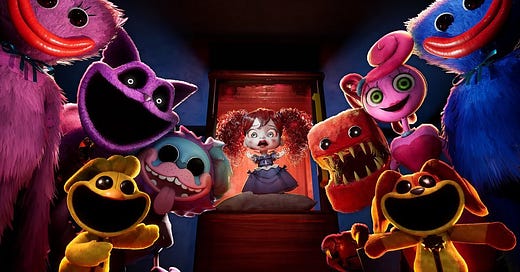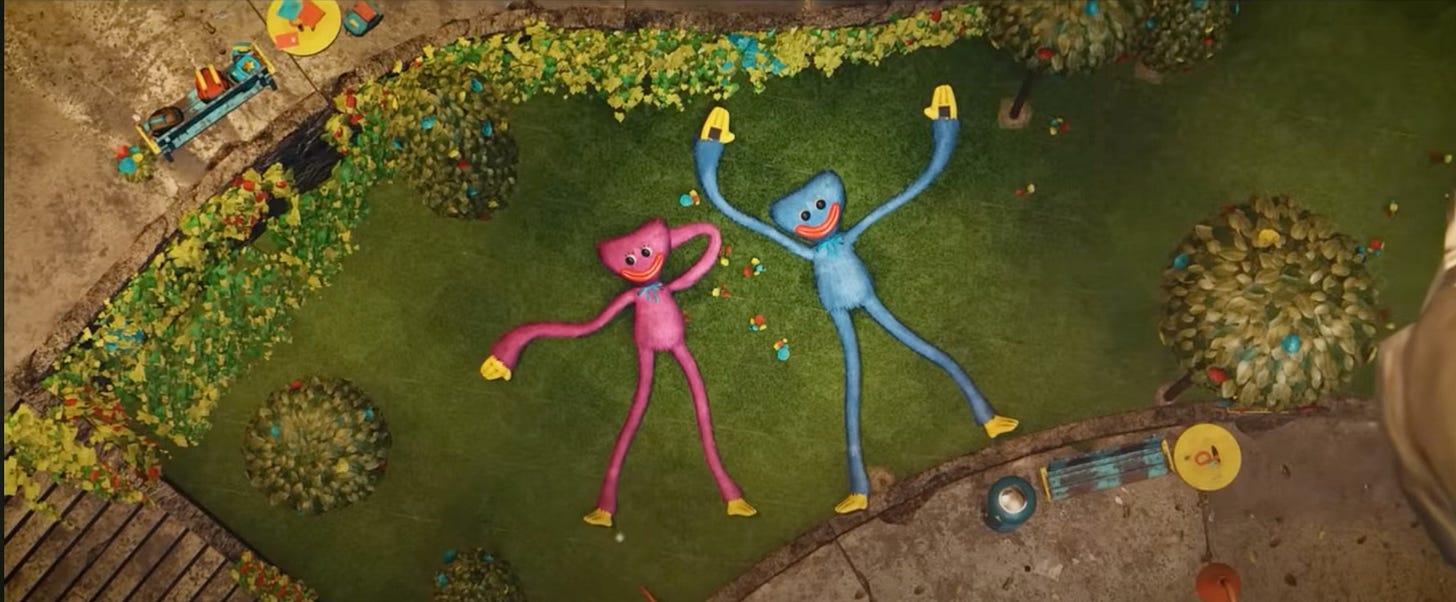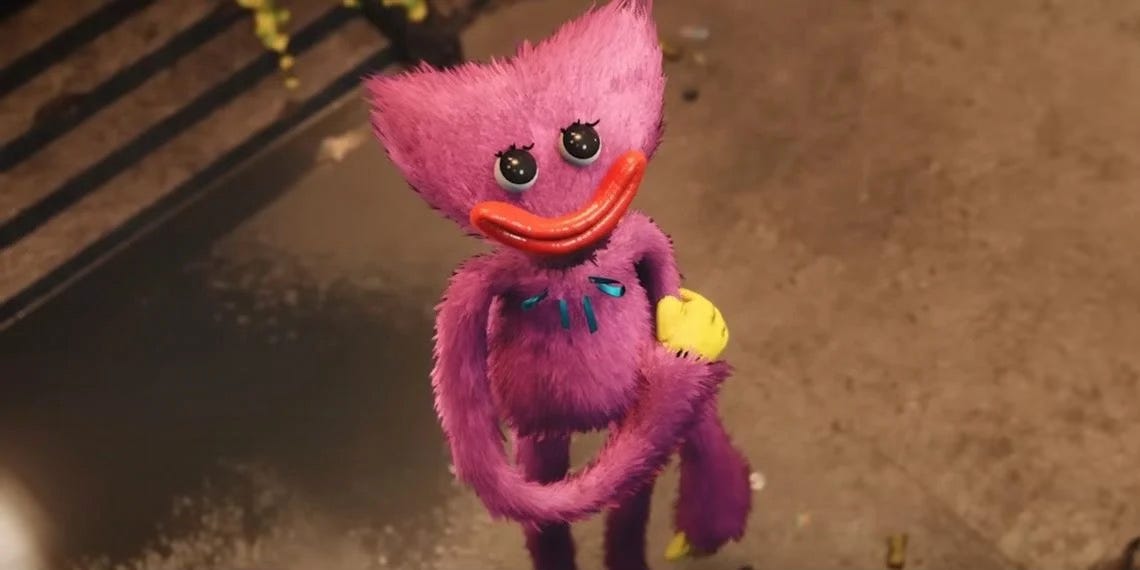Poppy Playtime and What Makes it Good Horror (The Trauma)
I'm a gamer now. This is a gaming outlet now, but sad. (Sorry, Aftermath).
This post contains Poppy Playtime: Chapter 4 spoilers. If you do not want to read spoilers for Poppy Playtime: Chapter 4, exit this newsletter after the list of book recommendations:
The Glass Castle, Klara and the Sun, You Too Can Have a Body Like Mine, Plastic, Perfect Victims and the Politics of Appeal. End of list!!!
Late night apartment-sitting, I’m suddenly watching three hours of both. I’ve been avoiding some heavy thoughts and relying on the Youtube algorithm to serve up background noise to cover the beating of my own heart: perfume reviews, thrift finds, lost media, Try Guys videos. For a few hours, I hit a perfectly sweet spot: dudes reviewing fast food. But dudes reviewing foods bleeds into dudes reviewing games and nothing gets views like a good jumpscare.
I hate horror games. I’m hopeless when it comes to puzzle games. But one walkthrough of Poppy Playtime leads to four, then videos of what was hidden, and videos of what was cut. The game’s premise is simple: Toy Story but Fucked Up (its working title). You’re an ex-employee at a toy company turned Disney-esque monopoly with its own fake town, coming back to the scene of a massacre you just barely missed. No one, not even you, knows what you’re looking for, but you were part of something you quickly realize is bleak—experimentation on children, integrating their bodies with the bodies of toys, on a quest for immortality.
This isn’t a unique premise—the draw, like other big horror games like Five Nights at Freddy’s, is that the ghosts in the machines are children. Hell, if you want to get bleak about it, experimentation is already a historical staple of fascist regimes and a real danger we’re on a slippery slope towards again. The thing about Poppy Playtime is that the victims of these experiments become more front-and-center as the series progresses. They’re just lonely kids, mostly orphaned, who were and are desperate for kindness, warmth, community and freedom. Even as the player gets attacked by the huge, twisted versions of them guarding what’s left of Playtime Co.’s ruins, you find evidence of their tenderness everywhere. Old drawings on the walls, diary entries in a graveyard of toys, makeshift forts and shrines dedicated to lost loved ones in the Safe Haven. There are VHS tapes and experiment files about them that slowly unveil the larger storyline, but Poppy Playtime, especially by Chapter 4, hits hardest with what it shares from the characters.
What I mean is, Poppy Playtime has a really penetrating way of presenting child abuse from the perspective of those who survive it—so visceral it’s almost photorealistic to those who know. It’s not in the gore itself, though there’s plenty of distorted footage. We see Poppy, our dodgy titular character, a porcelain doll whose catchphrase is “I’m a real girl. Just like you,” mid-experiment, blood and fat congealing around her recently extracted voice box, almost before anyone else. This is spliced into an innocent-seeming vintage tutorial on how to take care of your doll, but it’s not what makes your heart race. What makes your heart race are the small, recognizable moments. The way each character flinches sometimes, eyes widening others, the way they sway subconsciously, when talking about their abusers, their memories, about the prospect of ever going back. Kissy Missy, the peaceful foil to the now-iconic blue, fuzzy, many-toothed mascot of the series, Fuzzy Wuzzy, begins shaking the closer she gets to certain areas and when she hears the disgraced Doctor’s voice on the play walkie-talkie. Doey, a clay giant who is an amalgam of three boys, hyperventilates like a real person. His dominant persona is a strong leader, but his shifts to sentimental, idealistic, scared, and angry—somehow reflecting the fact that, yes, three distinct people are in there, but all three of those people are children and those are normal reactions and shifts for any given one. Like many survivors of abuse, some remain aligned with their abusers while others rebel. Both sets are just trying to live—that need, as base and as ugly and shameful as most people come to see it (Why is that? Why is need at all so often viewed as humiliating?) is plain. And like many survivors of abuse, some are warped farther and farther from who they initially were when the abuse began, their world quite literally shrinking into this small, unspeakably cruel place.
So when Poppy’s plan to save the orphans (presumably not experimented on yet, at least not in the same ways they were) taken underground by the Prototype after the Hour of Joy, they toys’ revolt, includes destroying Safe Haven and all of the toys who once dreamed of escaping Playtime Co., it hits close to home. There’s no dancing around it. Poppy lays out the reality so matter-of-factly that it comes across as a small detail in her plan. She says:
“The Red Smoke you’re directed from Playcare. It’s an accelerant. All it needs is high pressure and a little spark, and it ignites. The plan is: We’ll fill the foundation with the smoke, and line it with old missing charges. Then, once you, me, and Kissy have freed the orphans, our friends here will blow this place sky high. THAT’S our revenge.”
As the player, you feel like you might have misunderstood, but Doey leaves no room for that when he takes you aside shortly after. Yes, it’s the plan. Like the Prototype (arguably one of the only adults to be experimented on), Poppy can only see an end to Playtime Co.’s experiments by destroying everything the company has touched. There is no outside she can envision for the toys, despite taking part in their first revolt that killed every Playtime Co. worker complicit in the experiments and left them trapped underground.

Unfortunately, Poppy (and the Prototype) also come to a conclusion more common among survivors than most of us let on, however irrational: that to keep anyone else from being hurt, the abuser must be destroyed…and so must the abused.
A few years ago, my brother and I were home for Christmas Eve, holed up in our old bedroom playing video games and getting high. It’s not that we lived far enough that coming back here made us nervous, it’s that Christmas and our birthdays had always been toss ups—one of those markers of time that made our dad either a little manic or depressed. Either gregarious and drunk or angry and drunk, one sometimes turning on a dime into the other. We show up out of obligation (my brother diffusing as much as he can by bringing his girlfriend of a few years and her family), but we’re still just as tense as we were as kids. My parents had been grilling him: When were they getting married? When were they having kids? A weird line of questioning they’d never shown even a little interest in before, but my dad had been struggling to find threads he could pull at our psyches since we’d distanced ourselves the tiny bit we’d managed. “Maybe you’re living your life wrong,” was a solid way to get into either of our heads. The facts didn’t matter: that none of us could afford wedding rings, a wedding, a baby or two, even a future. Suddenly, my brother was sorely lacking—in a way that deprived our parents.
“You don’t have to do any of that. Definitely not on their fuckin’ timeline,” I broache. This is how we’ve always talked, facing screens, playing video games or watching bad TV. “As if we’d bring our kids around dad if we had any.”
“Oh, that’s not happening,” he says. “And like, I’m never having kids.”
“Never never?”
He nods.
“I think I’d be a good foster mom, but if I ever hit a kid, I think…” The pause gets uncomfortable. I decide to wrap it up.
“I think I’d have to kill myself.”
“Exactly,” he said, eyes locked forward, wet. “Exactly.”
That’s the last we spoke about it—but those who know, know. Sometimes this fear—that we are destined to repeat what was done to us, as though we are infected, or that as long as we exist, the abuse will come and will find us and will hurt everything we touch—is a cold hand around our necks. Sometimes it manifests into drinking. Addiction in general. Drugs, eating disorders, sex, obsessive-compulsive rules and rituals. It’s at once something that doesn’t need to be voiced and isn’t spoken about enough. You recognize it if you are someone who was abused or if you’ve loved someone who was abused. Two survivors crossing paths? Too often, that’s two people who love and fear each other with equal intensity.
Later in the game, the player overhears an argument between Poppy and Doey. It goes like this:
Doey: “The toys out there, in Safe Haven, they're my family... I understand what Poppy wants, what she believes is right. Destroy the factory. Destroy him. But I ask you to consider: If we throw everything away. Everyone. Just to kill the Prototype... How much do we waste?... I know the others might believe it's right. That we should bury everything. But…”
Doey: “I think you might be wrong, Poppy. What you want…”
Poppy: “It’s the best for everyone, Doey. That no trace of this place is left. We agreed to that.”
Doey: “I know... But us, everyone in there, we’re not just things gone wrong. We’re people...Can’t you see that?”
Poppy: “I can... And I’m sorry…”
We’re not just things gone wrong. Some days it’s harder to believe that than others. For many, this is in flux for the rest of their lives. It’s not as neat or tidy as anyone is comfortable with in survival stories. It’s not as uplifting as recounting all the success and love you may have found in-between or since. It’s just the truth—and maybe that’s why it comes into crisp focus, as it rarely does, in a horror game. What’s more immersive in horror than forcing the viewer to sit with and bear witness to their discomfort without blinking, until it’s unbearable? A heavy thought you can’t avoid, alone at night, no matter how you try.







